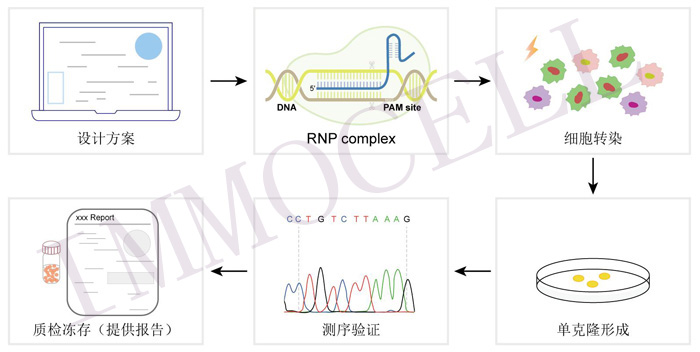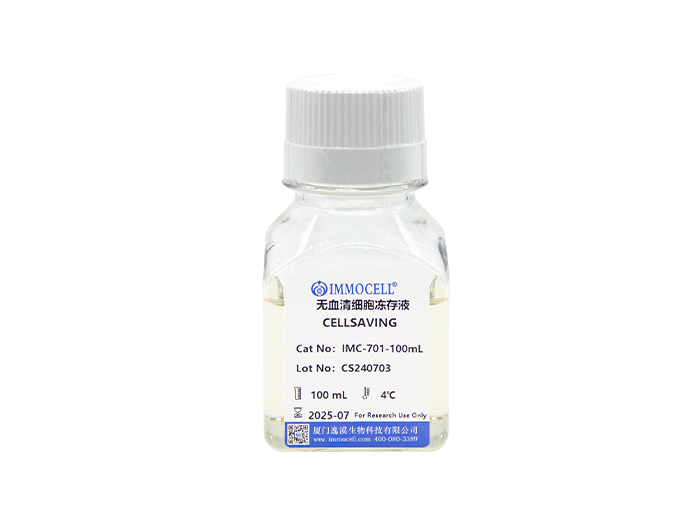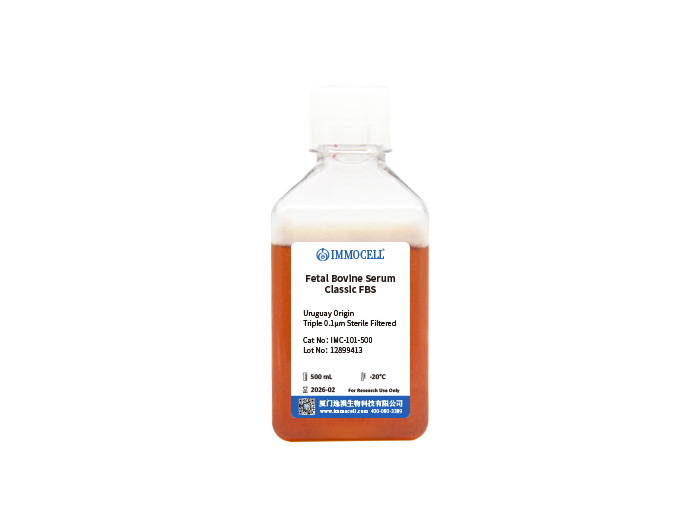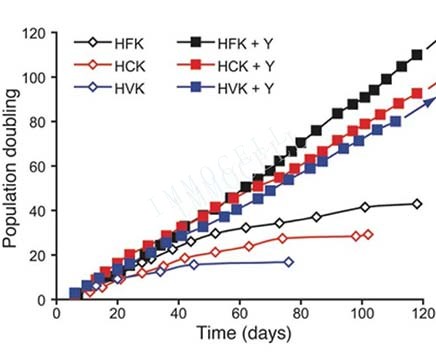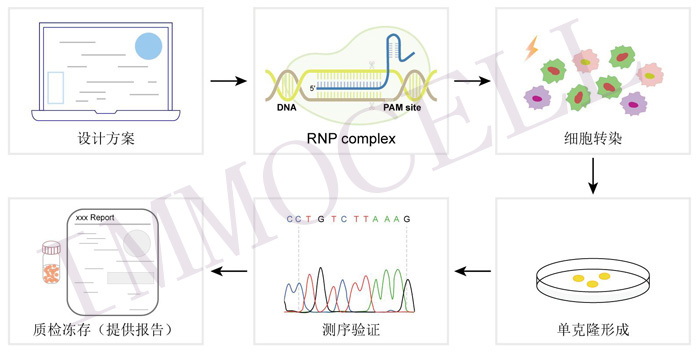| 产品名称 | PSMC5 knockout HeLa cell line | ||||
| 产品货号 | IMKO-H012 | ||||
| 产品规格 | 1×106cells/T25或1mL冻存管 | ||||
| 储存及运输 | 干冰运输;储存在液氮中 | ||||
| 产品分类 | Hela细胞 | ||||
| 物种 | 人 | ||||
| 修饰基因 | PSMC5 | ||||
| 修饰类型 | 基因敲除 | ||||
| 转导方法 | CRISPR/Cas9 | ||||
| 克隆类型 | 纯化克隆 | ||||
| 细胞鉴定 | 通过遗传学方法确认PSMC5基因敲除 | ||||
| 细胞形态 | 上皮细胞样 | ||||
| 生长特性 | 贴壁生长 | ||||
| 培养体系 | 90%MEM+10% FBS+1%PS | ||||
| 传代比例 | 1:2至1:3 | ||||
| 传代周期 | 每周3次 | ||||
| 培养条件 | 气相:95%空气+5%二氧化碳;温度:37℃ | ||||
| 冻存条件 | 无血清冻存液,液氮储存 | ||||
补充内容 | PSMC5即26S蛋白酶调节亚基8,也称为26S蛋白酶AAA-ATPase亚基Rpt6,是由PSMC5基因在人类中编码的酶。作为蛋白质编码基因,PSMC5在人体中衍生出重要的生物学功能,参与细胞内蛋白质降解并促进结肠癌细胞的增殖和转移。它作为一种新型的药物靶点或生物标志物,被广泛应用于药物研发领域。PSMC5在19S蛋白酶体复合物中是必需的亚基之一,与多种疾病有关,如Cockayne综合症和Ogden综合症。通过功能性实验和临床数据分析,揭示了PSMC5在CRC中的重要作用和机制。PSMC5的研究为理解细胞内蛋白质降解过程以及疾病发生发展提供了重要线索和参考。 | ||||
| 构建方法 |  | ||||
| PSMC5基因敲除细胞系的构建通常涉及的步骤 | 1. 设计 gRNA:选择目标 PSMD5 基因的特定区域,并设计适当的 gRNA (guide RNA) 序列,用于导向 CRISPR/Cas9 系统在目标基因上引发双链断裂。 2. 选择细胞系:选择适当的细胞系作为研究对象,通常选择易于转染且能够长期培养的细胞株。 3. 转染 CRISPR/Cas9 系统:将设计好的 gRNA 和 Cas9 蛋白共转染入目标细胞系中,使其形成 Cas9/gRNA 复合物,针对 PSMD5 基因发挥作用。 4. 筛选阳性细胞克隆:通过细胞筛选技术,筛选出成功敲除 PSMD5 基因的阳性细胞克隆,确保其基因敲除效率和稳定性。 5. 鉴定 PSMD5 基因敲除细胞系:利用 PCR、Western blot 或测序等技术验证目标 PSMD5 基因的敲除效果,确保已成功构建 PSMD5 基因敲除细胞系。 6. 功能鉴定和研究:进一步对 PSMD5 基因敲除细胞系进行功能研究,探究 PSMD5 基因在细胞生物学和疾病发生发展中的功能和机制。 | ||||
| PSMC5基因的基本信息 | Species | Gene Symbol | Gene ID | GenBank Accession | Transcript |
Human (Homo sapiens) | PSMC5 | 5705 | |||
| 关于基因 | Official Symbol | PSMC5 | |||
| Previous Symbol | PRS8 | ||||
| Official Full Name | Proteasome 26S Subunit, ATPase 5 | ||||
| Synonyms | HR55, MSS1, PRS8 | ||||
| Location | 17q23.3 | ||||
| Gene Type | protein-coding | ||||
| Uniprot ID | A8K3Z3, A8K763, O35051, O43208, P47210, P52915, P52916, P62195 | ||||
| Pathway/Library | PSMC5 participates in the proteasome pathway | ||||
| Gene Summary | The 26S proteasome is a multicatalytic proteinase complex with a highly ordered structure composed of 2 complexes, a 20S core and a 19S regulator. The 20S core is composed of 4 rings of 28 non-identical subunits; 2 rings are composed of 7 alpha subunits and 2 rings are composed of 7 beta subunits. The 19S regulator is composed of a base, which contains 6 ATPase subunits and 2 non-ATPase subunits, and a lid, which contains up to 10 non-ATPase subunits. Proteasomes are distributed throughout eukaryotic cells at a high concentration and cleave peptides in an ATP/ubiquitin-dependent process in a non-lysosomal pathway. An essential function of a modified proteasome, the immunoproteasome, is the processing of class I MHC peptides. This gene encodes one of the ATPase subunits, a member of the triple-A family of ATPases which have a chaperone-like activity. In addition to participation in proteasome functions, this subunit may participate in transcriptional regulation since it has been shown to interact with the thyroid hormone receptor and retinoid X receptor-alpha. Two transcript variants encoding different isoforms have been found for this gene. [provided by RefSeq, Nov 2010] | ||||
相关问题
培养指南
-
hiPSC人诱导多能干细胞培养教程:在培养hiPSC细胞前,需准备好hESC/iPSC完全培养基配制和Matrigel铺板,hiPSC人诱导多能干细胞复苏操作,1. 将水浴锅预热至37℃;并将Matrigel包被的6孔板,提前放置生物安全柜中约1小时恢复···...
阅读详情 -
H9人胚胎干细胞培养条件与方法:1. 将水浴锅预热至37℃,并将Matrigel包被的6孔板,提前放置生物安全柜中约1小时恢复至室温(15~30℃);2. 取4 mL hESC/iPSC完全培养基,按照1:4000比例加入1 μL的hESC/iPSC Supplement C,···...
阅读详情 -
H1人胚胎干细胞培养指南:在培养h1干细胞之前,首先要准备好hESC/iPSC完全培养基配制, 铺板,H1人胚胎干细胞复苏步骤:1.将水浴锅预热至37℃;并将Matrigel包被的6孔板,提前放置生物安全柜中约1小时恢复至室温(15~30℃);···...
阅读详情 -
4T1细胞培养方法:小鼠乳腺癌4T1细胞培养基 90%DMEM+10% FBS+PS,生长条件:气相:95%空气+5%二氧化碳;温度:37℃,4T1细胞形态特征为上皮细胞样,贴壁生长,如果4T1细胞密度达80%-90%,即可进行传代培养,传代方法:1:2至1:3···...
阅读详情 -
常用人肝癌细胞系有哪些及如何选择:目前较为常用的几株人肝癌细胞系SMMC-7721、Bel-7402、MHCC97、HepG2、Hep3B、Huh-7 and PLC/PRF/5,那么人肝癌细胞株如何选择呢?一方面你可以查找相关的文献,另一方面可以考虑选择···...
阅读详情 -
HL-60细胞生长慢解决方法及如何养好:当HL-60细胞传代后生长速度慢且状态不佳时,可竖着培养直到培养基变黄,待细胞密度起来后,状态会有所好转,同时,若HL-60细胞状态很差,可采用半换液的方式:以T25瓶子为例,瓶子里有5m···...
阅读详情

